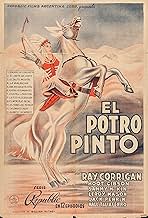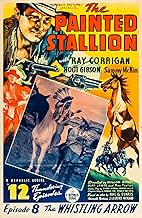The period is the 1820's and the first wagon train leaves Independence heading west to Santa Fe. In order to maintain his power, the ruthless Official at Santa Fe must not let them arrive an... Read allThe period is the 1820's and the first wagon train leaves Independence heading west to Santa Fe. In order to maintain his power, the ruthless Official at Santa Fe must not let them arrive and he sends out his men to stop them. The wagon train then has to endure repeated attacks b... Read allThe period is the 1820's and the first wagon train leaves Independence heading west to Santa Fe. In order to maintain his power, the ruthless Official at Santa Fe must not let them arrive and he sends out his men to stop them. The wagon train then has to endure repeated attacks but is aided by a mysterious rider that shoots singing arrows and rides a painted stallion.
- Oscar
- (as Oscar)
- Elmer
- (as Elmer)
- The Rider
- (as Julia Thayer)
- Macklin - Henchman
- (as Matson Williams)
Featured reviews
My only real complaint about this serial is that there is way too much reuse of footage...in fact one sequence is repeated word-for-word in two separate chapters. There are a couple of canyon ambushes that feature the same people falling to their dooms in each ambush. I know that they hafta do what they hafta do to cut costs...but that is a tad ridiculous.
Other than that, this is a really enjoyable serial, especially for a western serial. I'm a fan of the old b-westerns but western serials tend to drag on interminably at times. This one was fast paced and a joy to watch.
This western serial is apparently set around 1820. So, you see Jim Bowie and Davy Crocket--the same men who died at the Alamo in 1836. Yet, despite being such a very, very early western, you'd never know it because everyone fires revolvers and wears cowboy hats--which hadn't yet come into use. The earliest revolvers were being invented then and each chamber was hand-loaded (there were no cartridges) and a gun might be fired five or six times--but then took several minutes to reload. Well, that's NOT the case here, as the Colt .45 and other anachronistic weapons were used throughout the film. I know many viewers won't care about this sort of thing, but seeing clothing and guns from 30-40 years in the future annoys me--probably in part because I am a retired history teacher. Get it right folks--it just means doing a tiny bit of homework before you make the film.
As far as the acting goes, I was a bit disappointed. Although Ray Corrigan was the leading man, I assumed it was more an ensemble cast with his buddy, Hoot Gibson, getting equal treatment in the film--and I liked this thought since I really like Hoot Gibson films. Well, Gibson was pretty much a minor character. I also didn't like all the attention the kid (who was SUPPOSED to be a young Kit Carson) got in the film--as most child actors are pretty annoying. So, with these folks starring in the film, it's obvious that Fulton's bad acting would NOT be overshadowed by the rest of the cast--since the cast were all semi-mythical representations of real western characters. Carson, Bowie and Crocket did NOT pal around together!
Overall, this isn't a terrible western serial, but it isn't all that good of one either. There are many dull patches, the reuse of scenes for the sake of economy and the mistakes I've already mentioned. While most serials were rather slapped together and often played loose with the facts, even without all this the serial wasn't nearly as interesting as many others such as "The Adventures of Captain Marvel" or "Spy Smasher". Worth a look only if you are a devoted serial junkie.
Anyway, "The Painted Stallion" is pretty standard Western Movie fare, but the thing that breaks the formula with other Westerns is that there are 3 heroes who rode together (instead of a single hero, like Gene Autry or Roy Rogers), and the movies would always have a "sidekick", so the Good Guy would have someone to talk to when no one else was around. The sidekick was guaranteed to be on the Good Guy's side in the story, as well as providing the "Comic Relief", for when things got heavy for the Good Guy. And of course there would be any number of Bad Guys and their evil minions, because you'd have a pretty boring film without Bad Guys to vanquish, right before the ending. Kids, when you study what comprises a story (even Shakespeare or "A Christmas Carol"), you'll learn about Protagonists (Good Guys) and Antagonists (Bad Guys). And I was so busy explaining The Old Days, I missed the end of this one! Now I'll have to find out when it's running again, just to see the last 10 minutes!! I'll update this review after that. What I CAN tell you at the moment is that "The Painted Stallion" was an enjoyable old-time Western, with lots of action and "Bang-bang-shoot-'em-up"-type scenes, as a good western should! I can tell you that one of our three heroes, the one in the South of the border Sombrero is none other than Duncan Renaldo. He was one of the original Three Mesquiteers, and when TV finally showed up (delayed a few years by this little thing called World War II), Renaldo (spelled "Reynaldo" later)
Of course this is of some interest in Washington, DC where the president would have been James Monroe and the Secretary of State John Quincy Adams. They send Ray Corrigan on a diplomatic mission to negotiate a trade treaty for Americans in Santa Fe.
Ray Corrigan may have been the most unusual diplomat ever sent on a trade mission by our State Department. Instead of going to Mexico City to negotiate with the government there, he's sent to Santa Fe to deal with provincial officials. And of course every diplomat I know comes not only with letters of credentials, but six guns and buckskins. Six guns, by the way, that Samuel Colt has not invented yet.
Corrigan hooks up with a wagon train headed by wagonmaster Hoot Gibson. Also along for the ride are scouts Davy Crockett and Jim Bowie who never met until the Alamo and also there's young scout-in-training, Kit Carson.
Gibson and Corrigan with the aide of their trusty scouts and a mysterious Indian princess who rides a painted stallion and shoots 'singing' arrows get the wagon train through and then have to deal with the bad guys after getting to Santa Fe.
Every time I see one of these old movie serials I am astounded at how bad they are. Forget Olivier and Brando, the guys who had to say some of this dialog with a modicum of sincerity may be the greatest players the world has ever known. I can't see how the cast kept a straight face.
I guess this only proves one thing, one of the qualifications of a U.S. diplomat back in the day was one's ability with a six gun. And seeing how Ray Corrigan constantly got himself out of one scrape after another, John Quincy Adams would have been proud.
Did you know
- TriviaDirectorial debut of William Witney. NOTE: The original director was Ray Taylor, but when he fell far behind schedule--crew members interviewed years later said that he often showed up for work drunk or began drinking early on the set, which was why production fell behind so much--he was removed and Witney, who was an assistant director, was told by the studio to finish the picture.
- GoofsThe "mule" Roberto, introduced in Chapter Seven, is actually a small horse which has been made up to look like a mule. I know modern mules have long tail hair, but this movie is set at a time before they were even bred, and the word "mule" meant the same thing as "donkey." Even its braying is fake and has been dubbed.
- ConnectionsEdited into Wild West Days (1937)
Details
Box office
- Budget
- $109,164 (estimated)
- Runtime3 hours 32 minutes
- Color
- Aspect ratio
- 1.37 : 1
Contribute to this page




























